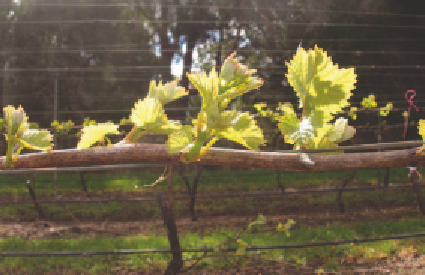Agriculture Reference
In-Depth Information
previous season, so once the framework has
been established, select side growths about 30
to 40 cm apart and prune to two buds from
the framework. From this point on the pruner
must be ruthless. Kiwifruit can be difficult to
pollinate so keep the vine open to allow
maximum bee access. Plant some bee-
attracting plants nearby and even hand
pollination will boost fruit set (see
Figure 4.96).
Figure 4.95
The new fruiting growth arising from last
year's cane.
Once the trunk and major branches
have been established, pruning for fruit
can begin.
Kiwifruit
Actinidiadeliciosa
,syn.
A.chinensis
Kiwifruit, also known as Chinese gooseberry,
is a rampant grower and therefore needs a
strong hand to keep it manageable. Like the
grape, fruit is borne on new growth arising
from a bud formed the previous season.
Male and female plants are required for fruit
production; the vines vary only in the shape
of their f flowers. The only time they can be
differentiated is when they are f flowering, so
always prune back the male directly after
f flowering to avoid confusion. Males f flower
on the same wood as the female so prune
them in the same manner, just earlier. Cut
out the f flowered wood and shorten back the
side growths to produce next season's
f flowering wood.
Summer pruning
The vine will have produced masses of new
growth from its main arms. Most of this
should be removed, especially the vertical
and extremely vigorous. Prune back the
fruiting canes (arising from last year's stubs)
to two to four buds beyond the set fruit. This
will direct the vines energy into fruit
development rather than useless vegetative
growth. In hot regions leave more buds to
shade the fruit; in cooler climes, leave less to
allow light in to ripen the fruit. Cut out all
other vegetative growth excepting a less
vigorous shoot near the fruiting arm. Shoots
with horizontal growth and buds packed
closely together are the most fruitful. These
can be shortened to two to three buds that
will provide next year's harvest. Other leafy
growth can be removed throughout the
summer as it arises.
Train the vine to a trunk as with wisteria and
grapes (see Figure 4.89), selecting two or
more stems to act as the vines framework.
Always tie kiwifruit stems to their support,
never twist them around as they can strangle
themselves and sap flow is reduced.
Winter pruning
Always prune in early to mid winter as the
vines tend to 'bleed' their sap later in the
As mentioned before, kiwifruit crop on new
growth arising from a bud formed the

